Only since 1994 when the Republic of South Africa became an independent democracy have Indian tourists begun visiting this scenic nation of silvery beaches, lofty peaks and spectacular wildlife reserves, reports Bharati Thakore
.gif) To the credit of the first government of independent India and its first prime minister Jawaharlal Nehru, one of the first policy initiatives of the newly independent nation was to sever all trade and diplomatic links with the Union of South Africa, then ruled by a white minority regime which rigorously imposed the reprehensible white supremacist doctrine or apartheid within its national borders.
To the credit of the first government of independent India and its first prime minister Jawaharlal Nehru, one of the first policy initiatives of the newly independent nation was to sever all trade and diplomatic links with the Union of South Africa, then ruled by a white minority regime which rigorously imposed the reprehensible white supremacist doctrine or apartheid within its national borders.
Consequently it’s only since 1994, when the Republic of South Africa (RSA) became an independent democracy under the leadership of Nelson Mandela (who had been incarcerated in prison for 27 years by the white minority government), that Indian tourists began to visit this beautiful country of striking topography manifested in its silvery beaches, loft peaks and spectacular wildlife reserves. RSA is also of special historical significance for people of the Indian subcontinent. It was here at the turn of the 20th century that Mahatma Gandhi conceptualised and tested his unique political mobilisation doctrines of satyagraha and ahimsa, before returning to India in 1915.
Unsurprisingly, following independence and the end of apartheid, this huge (1.2 million sq km) multi-racial country of 11 official languages has become a hotspot destination attracting 7 million tourists, who spent $9.17 billion (Rs.41,265 crore) and generated employment for 919,800 citizens in 2009. In comparison, India attracted only 5 million foreign tourists in 2009. In 2010 when RSA hosted the superbly organised FIFA World Cup football championship, the country welcomed a record 8 million tourists, generating revenues of R3.6 billion (Rs.2,234 crore).
“The sunny weather, beautiful scenery, historical sites and happening nightlife are some of the main attract-ions of South Africa. For those interested in sightseeing, adventure sports, and safaris there is no shortage of things to do. The people are friendly and helpful and the service excellent. I especially fell in love with Cape Town, which has so many gorgeous attract-ions like Table Mountain, Cape Point and the Waterfront. The city is sparkling clean and well organised, making it a pleasure to walk around. There is also a booming fashion industry in Cape Town which was of great interest to me,” says Mumbai-based fashion photo-grapher Nandini Mehta who recently visited RSA.
Hosting an Indian-origin population of over 1 million with 75 percent living in the eastern port of Durban, RSA (pop.50 million) is fast emerging as a fun and recreational mecca for tourists from the subcontinent. In 2010, 71,587 tourists from India holidayed in this scenic multi-cultural country for an average seven days.
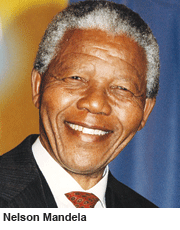 Although fossil remains indicate that present-day South Africa was inhabited by primitive homo sapiens almost 3 million years ago, Bantu tribesmen began farming in this area in the fourth and fifth century CE (Christ Era). But their idyllic lifestyles were interrupted when Jan van Riebeeck and 90 men established a refreshment station on the Cape of Good Hope (later Cape Town) for the Dutch East India Com-pany. As a result of developments in Europe, the British took over the Cape from the Dutch in 1795. In the 19th century following the discovery of diamonds and gold in peninsular Africa, the Anglo-Boer Wars broke out between the Dutch settlers (Boers) and the British for control of the region’s mineral wealth, and Cape Town became a British colony in 1806. Two decades later, some 12,000 Boers protesting British rule departed from the Cape colony and established the Boer republics of Natal, Orange Free State and the Transvaal.
Although fossil remains indicate that present-day South Africa was inhabited by primitive homo sapiens almost 3 million years ago, Bantu tribesmen began farming in this area in the fourth and fifth century CE (Christ Era). But their idyllic lifestyles were interrupted when Jan van Riebeeck and 90 men established a refreshment station on the Cape of Good Hope (later Cape Town) for the Dutch East India Com-pany. As a result of developments in Europe, the British took over the Cape from the Dutch in 1795. In the 19th century following the discovery of diamonds and gold in peninsular Africa, the Anglo-Boer Wars broke out between the Dutch settlers (Boers) and the British for control of the region’s mineral wealth, and Cape Town became a British colony in 1806. Two decades later, some 12,000 Boers protesting British rule departed from the Cape colony and established the Boer republics of Natal, Orange Free State and the Transvaal.
With the conflict intensifying, the First Boer War (1880-81) ended in a stalemate. But in the Second Boer War (1899-1902), the British won a decisive victory. In 1910 the several territories and republics were legislated into the Union of South Africa, and in 1931 the union was granted dominion status and virtual independence under white rule. In 1948, the Boer-dominated National Party was elected to power and formalised apartheid under which the majority black, Indian and mixed races suffered severe discrimination, deprivation and arbitrary torture and imprisonment. Finally in 1994 following internal and external opposition, the apartheid system fell apart and Nelson Mandela was elected the first black president of RSA in the country’s first ever democratic election in which all adult citizens were entitled to vote.
In an unprecedented act of reconci-liation and forgiveness, President Mandela and the African National Congress (ANC) which was heavily influenced by the teachings and example of Mahatma Gandhi, persuaded the black majority of RSA to forgive and forget the horrors of apartheid and almost two centuries of oppressive racism. Since then, this young rainbow democracy has prospered and is on the verge of massive economic growth and development. It is the world’s largest producer and exporter of platinum, and a heavyweight producer of gold and diamonds. Moreover the country’s manufacturing industry is a world leader in several specialised sectors, including motor vehicle accessories, and mining equipment and machinery.
Meanwhile, as the South African economy is growing at high speed, the country’s superbly organised tourism industry is gradually becoming its lifeblood. Besides offering a wide array of natural and man-made attractions, water sports, powdery beaches and varied wildlife, South Africa also offers excellent logistics, well-developed infrastructure and a wide range of hotel accommodation with The Taj Cape Town — of the Mumbai-based Taj Mahal hotels chain — having been inaugurated in January this year. Moreover this newly-born rainbow nation offers gourmet cuisine which can be washed down with world class wines from the Cape Winelands. For those who prefer more conventional cuisines, there is a spectrum of restaurants with maestro chefs offering a range of French, Chinese, Indian and Italian fare.
The best time to visit South Africa is in summer (November-March) although the climate is temperate year round. But there are differing best times depending on personal preferences. For safaris, June-September is ideal. Avoid a visit to Cape Town between May-August as it is cold, windy and rainy.
Getting there. Daily direct flights link Johannesburg to Mumbai and Delhi.
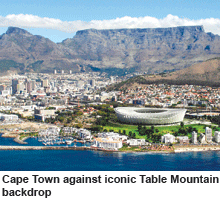 Cape Town. The second largest city in South Africa, Cape Town (pop. 3.5 million) is located in the south-west near the Cape of Good Hope, and is the southernmost city of the African continent. Founded by Jan van Riebeeck as a trading post for the Dutch East Indies company, this mother city of RSA is optimally sited with the iconic Table Mountain slap-bang in her centre, surrounded by white sandy beaches. Circling Cape Town are the tranquil Cape vineyards of Constantia, Paarl, Stellenbosch and Franschhoek, delightful for hanging out and wine-tasting.
Cape Town. The second largest city in South Africa, Cape Town (pop. 3.5 million) is located in the south-west near the Cape of Good Hope, and is the southernmost city of the African continent. Founded by Jan van Riebeeck as a trading post for the Dutch East Indies company, this mother city of RSA is optimally sited with the iconic Table Mountain slap-bang in her centre, surrounded by white sandy beaches. Circling Cape Town are the tranquil Cape vineyards of Constantia, Paarl, Stellenbosch and Franschhoek, delightful for hanging out and wine-tasting.
Cape Town offers ample recreation ranging from outdoor sports, adven-tures in the sun to a roaring neon-lit night life. The assorted blend of clubs, bars and restaurants in the city reflect its multi-cultural history, and cater to every palate and experience — from fast-food and beer-quaffing to chic and elegant dining.
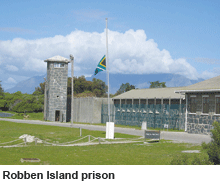 Robben Island. Now a UNESCO World Heritage site, Robben Island is a short ferry ride from Cape Town and is most famously known as the prison where Mandela and the country’s top political leaders were incarcerated by the white minority apartheid regime.
Robben Island. Now a UNESCO World Heritage site, Robben Island is a short ferry ride from Cape Town and is most famously known as the prison where Mandela and the country’s top political leaders were incarcerated by the white minority apartheid regime.
Today, tourists can visit the maximum-security wing where President Mandela was imprisoned for 27 years, and forced to do hard labour in the contiguous lime quarry. Tours of Robben Island are usually conducted by former political prisoners, who describe life on this island prison in poignant detail.
Johannesburg. Modern, chic and cosmopolitan, this charming city represents the spirit of South Africa, and any visit to this vibrant new republic remains incomplete without an intro-duction to Joburg, Jozi or Egoli (place of gold) as it is variously known. Indeed, mining dumps are never far away, rubbing shoulders with the fruits of its labour — shiny steel and glass skyscrapers intermingled with the classic elegance of 19th century architecture. Johannesburg (pop. 7.15 million) is the largest city in the world not situated on a lake, navigable river or by the coast (its raison d’etre is the region’s gold mines) with the country’s tallest building — the Carlton Centre — dominating its skyline.
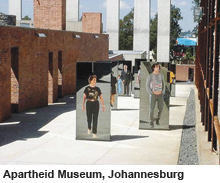 Sights in Johannesburg include the new Museum Africa which offers an honest and self-critical look at the nation’s troubled past, the Market Theater Complex which hosts a large theatre community, and a Saturday flea market. Also worth checking out is the Smuts Library at the University of the Witwatersrand (Wits University) where South African statesman Jan Smuts’ book collection is preserved, and the university’s Gubbins Library which houses an extensive collection of books on Africa. The Apartheid Museum, contiguous to the Gold Reef City theme-park, is a poignant reminder of the dark history of apartheid and the oppression of the native people of South Africa. Somewhat paradoxically, a visit to the Apartheid Museum — far from being harrowing — could prove to be uplifting.
Sights in Johannesburg include the new Museum Africa which offers an honest and self-critical look at the nation’s troubled past, the Market Theater Complex which hosts a large theatre community, and a Saturday flea market. Also worth checking out is the Smuts Library at the University of the Witwatersrand (Wits University) where South African statesman Jan Smuts’ book collection is preserved, and the university’s Gubbins Library which houses an extensive collection of books on Africa. The Apartheid Museum, contiguous to the Gold Reef City theme-park, is a poignant reminder of the dark history of apartheid and the oppression of the native people of South Africa. Somewhat paradoxically, a visit to the Apartheid Museum — far from being harrowing — could prove to be uplifting.
 Kruger National Park. Sprawling over the Limpopo Province, this is the most awesome game reserve in South Africa. Hosting an impressive array of 336 trees, 49 fish, 34 amphibians, 114 reptiles, 507 birds and 147 mammalian species, Kruger also contains archaeol-ogical sites such as Masorini, where evidence of human life 1.5 million years ago is displayed.
Kruger National Park. Sprawling over the Limpopo Province, this is the most awesome game reserve in South Africa. Hosting an impressive array of 336 trees, 49 fish, 34 amphibians, 114 reptiles, 507 birds and 147 mammalian species, Kruger also contains archaeol-ogical sites such as Masorini, where evidence of human life 1.5 million years ago is displayed.
As well as ‘The Big Five’ (buffalo, elephant, leopard, lion and rhino), Kruger National Park is the natural habitat of ‘The Little Five’ (buffalo weaver, elephant shrew, leopard tortoise, ant lion and rhino beetle), the ‘Birding Big Six’ (ground hornbill, kori bustard, lappet-faced vulture, martial eagle, pel’s fishing owl and saddle-bill stork), and the ‘Big Five Trees’ (baobab, fever tree, knob thorn, marula, mopane). So don’t forget to pack your binoculars!
Gansbaai. Uniquely, RSA offers wildlife and game spotting on terra firma and below its pristine water world as well. Gansbaai is the undisputed Great White Shark capital of the world and advent-urous visitors have the opportunity to go shark spotting underwater. But even for the less adventurous, Gansbaai — four hours by road from Cape Town — offers natural, unspoilt beauty both in and out of the water. You can whale- watch from the cliffs of De Kelders, enjoy miles of pristine white sand on Pearly Beach, stroll in ancient milkwood forests, visit the penguin colony of Dyer Island, spot cape clawless otters and black oyster catchers at work on Gansbaai’s secluded beaches.
The Garden Route. Stretching 800 km from Mossel Bay in the Western Cape to the Storms River on the Eastern Cape border, the Garden Route is an immense scenic stretch of RSA’s south-eastern coast. Look out for over 300 avian species; enjoy the route’s ten nature and marine reserves abundant with coral reefs, dolphins, seals and other marine creatures. In several bays along the Garden Route, there are the Southern Right Whale nurseries where whales come to calve in the July-December season.
The Drakensberg Mountain Range. Known by the native Zulu as uKhahlamba (the Barrier of Spears), the Drakensberg, a World Heritage site, is a 200 km-long range of mountains extending into KwaZulu-Natal province. The craggy and imposing Drakensberg range is a paradise for walkers, adven-ture seekers and wildlife lovers alike. Rock and cave art painted by the now extinct San tribe — also known as the Bushmen — depicting the everyday life of cavemen several thousand years ago, can be seen across the range, and these paintings are definite must-sees. Outdoor aficionados can hike, ride, rock climb, abseil, white water raft and more.
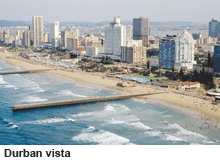 Durban. High up on the east coast, Durban (pop. 3 million) — the closest seaport to Johannesburg — is South Africa’s sub-tropical beach getaway. The city centre overlooks a long, golden beach that is probably the most culturally diverse spot in Africa. The best feature of Durban is that the water temperature is rarely below 20°C which makes it ideal for swimming and surfing.
Durban. High up on the east coast, Durban (pop. 3 million) — the closest seaport to Johannesburg — is South Africa’s sub-tropical beach getaway. The city centre overlooks a long, golden beach that is probably the most culturally diverse spot in Africa. The best feature of Durban is that the water temperature is rarely below 20°C which makes it ideal for swimming and surfing.
Sited in the middle of a vast sugar-growing area developed by indentured labour from India, many of whom stayed, started businesses and built homes, an oriental ambience characterises Durban’s huge spice market, its decorative mosques, elaborate Hindu temples and restaurants. For outdoor exploits, Durban offers river excursions, abseiling, trekking and visits to small game farms. The North and South coasts, within an hour’s drive of the city, are packed with myriad restaurants, excellent theatres, funky nightlife venues and a high density of championship golf courses.
Another interesting spot to visit is Inanda, which was the birthplace of both the Shembe native religion and Natal Native Congress, which later transformed into the ANC, which under Mandela’s indomitable leadership wrested freedom and democracy from the white minority National Party in 1994. Mahatma Gandhi also lived here for several years and developed his empire-breaking doctrines of satyagraha and ahimsa.